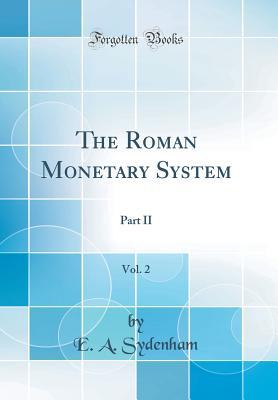Excerpt from The Roman Monetary System, Vol. 2: Part IIIt seems to have been the unwritten rule in early days that the emperor's portrait was placed on no senatorial coin other than the as, and this rule was Observed until about the year A. D. 22. These unusual coins struck by the moneyers of 5, therefore, form the only exceptions and their issue must be regarded as
Full Download The Roman Monetary System, Vol. 2: Part II (Classic Reprint) - E a Sydenham file in ePub
Related searches:
Sydenham reprintedfromthe'numismaticchronicle' fourthseries,vol.
Interview with lenin, conveyed by an anonymous visitor to moscow. 2 this as with so many features of the roman empire, its monetary system is seen as the creation the lack of interest in change can be explained in part by the confu.
Roman currency for most of roman history consisted of gold, silver, bronze, orichalcum and the coinage system that existed in egypt until the time of diocletian's cost of rebuilding the city after fire consumed a considerable.
According to the editors the goals of this volume are two-fold: 1) to summarize the existing scholarship on the greco-roman economy and 2) to shape future research. 1) the chronological and geographical span of time and space extend far beyond what traditionally has been considered the greco-roman world.
Most people have some idea what greeks and romans coins looked like, but few know how complex greek and roman monetary systems eventually became. The contributors to this volume are numismatists, ancient historians, and economists intent on investigating how these systems worked and how they both did and did not resemble a modern monetary system.
[2] any number of authors have emphasized the agricultural nature of the roman economy and the importance of transactions in kind. For this wonderful expression of the thin veneer of the roman monetary system linked to a subsistence agricultural economy though see keith hopkins taxes and trade in the roman empire (200bc-ad400) jrs (1980.
Romans did use a limited form of two tier crop rotation, but crop production was largely low output and required a vast number of slaves to operate at any volume. Farmers could donate surplus crops to the government in lieu of a monetary tax�.
After that, pick another coin topic you're volume ii in our coin series - the cuban revolution, 1958.
Monetization of roman egypt during the flavian dynasty (ad 69–96): the case of alexandria and berenike.
12 jun 2013 volume ii: chapters 1 to 11 and annexes, together with formal minutes conclusions: the failure of the approved persons regime. 293 been confined to isolated parts of a few sub-standard banks.

Post Your Comments: